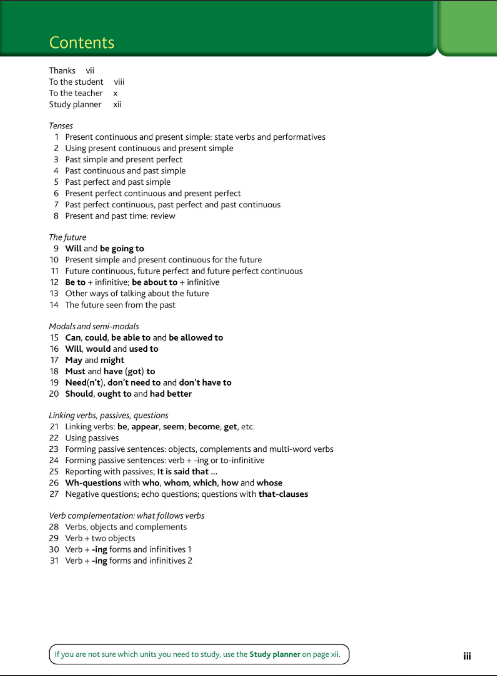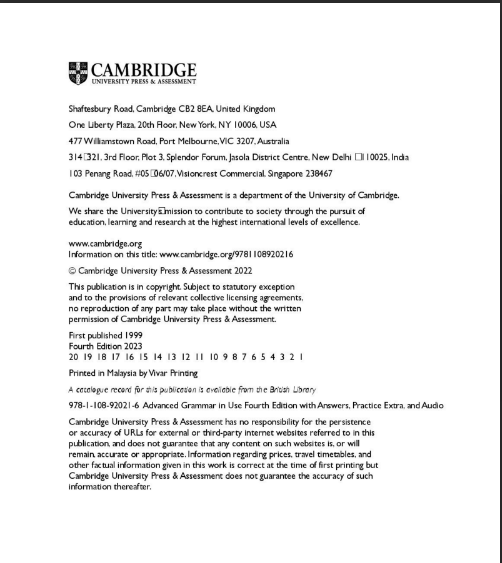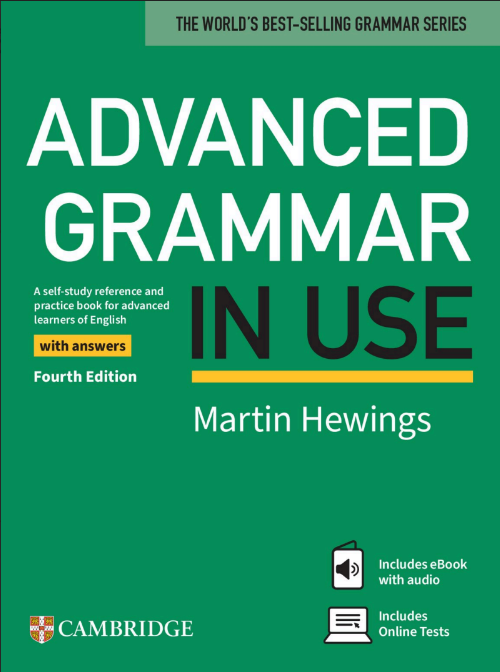


Cambridge University Press & Assessment Details** **CAMBRIDGE UNIVERSITY PRESS** Cambridge, New York, Melbourne, Madrid, Cape Town, Singapore, São Paulo, Delhi, Mexico City Cambridge University Press The Edinburgh Building, Cambridge CB2 8RU, UK www.cambridge.org Information on this title: www.cambridge.org/9781108920216 © Cambridge University Press & Assessment 2022 This publication is in copyright. Subject to statutory exception and to the provisions of relevant collective licensing agreements, no reproduction of any part may take place without the written permission of Cambridge University Press & Assessment. First published 1999 Fourth Edition 2023 20 19 18 17 16 15 14 13 12 11 10 9 8 7 6 5 4 3 2 1 Printed in Malaysia by Vivar Printing A catalogue record for this publication is available from the British Library 978-1-108-92021-6 Advanced Grammar in Use Fourth Edition with Answers, Practice Extra, and Audio Cambridge University Press & Assessment has no responsibility for the persistence or accuracy of URLs for external or third-party internet websites referred to in this publication, and does not guarantee that any content on such websites is, or will remain, accurate or appropriate. Information regarding prices, travel timetables and other factual information given in this work is correct at the time of first printing but Cambridge University Press & Assessment does not guarantee the accuracy of such information thereafter. — **Image 2: Contents (Part 1)** **Contents** Thanks vii To the student viii To the teacher ix Study planner xii **Tenses** 1 Present continuous and present simple: state verbs and performatives 2 Using present continuous and present simple 3 Past simple and present perfect 4 Past continuous and past simple 5 Past perfect and past simple 6 Present perfect continuous and present perfect 7 Past perfect continuous, past perfect and past continuous 8 Present and past time: review **The future** 9 Will and be going to 10 Present simple and present continuous for the future 11 Future continuous and future perfect continuous 12 Be to + infinitive; be about to + infinitive 13 Other ways of talking about the future 14 The future seen from the past **Modals and semi-modals** 15 Can, could, be able to and be allowed to 16 Will, would and used to 17 May and might 18 Must and have (got) to 19 Need(n’t), don’t need to and don’t have to 20 Should, ought to and had better **Linking verbs, passives, questions** 21 Linking verbs: be, appear, seem, become, get, etc. 22 Using passives 23 Forming passive sentences: objects, complements and multi-word verbs 24 Forming passive sentences 2: verb –ing or to-infinitive 25 Reporting with passives: It is said that … 26 Wh-questions with who, whom, which, how and whose 27 Negative questions; echo questions; questions with that-clauses **Verb complementation: what follows verbs** 28 Verbs, objects and complements 29 Verb + two objects 30 Verb + -ing forms and infinitives 1 31 Verb + -ing forms and infinitives 2 If you are not sure which units you need to study, use the Study planner on page xii. — **Image 3: Contents (Part 2)** **Reporting** 32 Reporting people’s words and thoughts 33 Reporting statements: that-clauses 34 Verb + wh-clause 35 Tense choice in reporting 36 Reporting offers, suggestions, orders, intentions, etc. 37 Modal verbs in reporting 38 Reporting what people say using nouns and adjectives 39 Should in that-clauses; the present subjunctive **Nouns** 40 Agreement between subject and verb 1 41 Agreement between subject and verb 2 42 Agreement between subject and verb 3 43 Compound nouns and noun phrases **Articles, determiners and quantifiers** 44 A / an and one 45 A / an, the and zero article 1 46 A / an, the and zero article 2 47 A / an, the and zero article 3 48 Some and any 49 No, none (of) and not any 50 Much (of), many (of), a lot of, lots (of), etc. 51 All (of), whole, every, each 52 Few, little, less, fewer **Relative clauses and other types of clause** 53 Relative pronouns 54 Other relative words: whose, when, whereby, etc. 55 Prepositions in relative clauses 56 Other ways of adding information to noun phrases 1: additional noun phrases, etc. 57 Other ways of adding information to noun phrases 2: prepositional phrases, etc. 58 Participle clauses with adverbial meaning 1 59 Participle clauses with adverbial meaning 2 **Pronouns, substitution and leaving out words** 60 Reflexive pronouns: herself, himself, themselves, etc. 61 One and ones 62 So and not as substitutes for clauses, etc. 63 Do so; such 64 More on ellipsis after auxiliary verbs 65 Ellipsis of to-infinitives — **Image 4: How to use the book & New Units** **How to use the book** It isn’t necessary to work through the units in order. First, have a look through the whole book to see what is there. The Study Planner will help you decide which units to study. Do the multiple-choice questions and check your answers, then go to the relevant unit in the book for further study, or to the relevant Grammar Reminder section for further reading. Alternatively, find a specific grammar point in the Contents at the start of the book or in the more detailed Index at the back. The Key to Exercises, as well as Additional Exercises for further practice of grammar points, are at the back of the book. Use the Glossary for explanations of grammar terms used in the book and the Appendices for more information on irregular verbs and passive verb forms. Go online for easy access to Mobile-Friendly Ten-Minute Tests. **Grammar in Academic contexts** FIVE NEW UNITS focus on Grammar in Academic Contexts specifically for students using English at college or university. These units will help you to: * produce more accurate English in your written work; * give better academic presentations; * read your textbooks more efficiently; * follow your lectures and presentations more easily; * reflect on your work and learn from your mistakes. **Where will learning English take you?** We know you want to enjoy learning grammar and feel supported too. That’s why we have made all the learning materials – whether in the book or online – easy to use. Advanced Grammar in Use will keep you engaged and provide the practical skills you need to succeed in both exam and everyday life English. Read on to start your English learning journey today.
**Adjectives and adverbs** 66 Position of adjectives 67 Gradable and non-gradable adjectives: using adjectives with adverbs 68 Gradable and non-gradable adjectives: differences in meaning 69 Participle adjectives and compound adjectives 70 Adjectives + to-infinitive, -ing, that-clause, wh-clause 71 Adjectives and adverbs 72 Adjectives and adverbs: comparative and superlative forms 73 Comparative phrases and clauses 74 Position of adverbs: end position 75 Position of adverbs: front and mid position 76 Adverbs of place, direction, indefinite frequency, and time 77 Degree adverbs and focus adverbs 78 Comment adverbs and viewpoint adverbs **Adverbial clauses and conjunctions** 79 Adverbial clauses of time 80 Giving reasons: as, because, etc.; for and with 81 Purposes and results: in order to, so as to, etc. 82 Contrasts: although and though; even though / if; while, whilst and whereas 83 If 1 84 If 2 85 If I were you …; imagine he were to win 86 If … not and unless; if and whether; etc. 87 Connecting ideas in a sentence and between sentences **Prepositions** 88 Prepositions of position and movement 89 Between and among 90 Prepositions of time 91 Talking about exceptions 92 Prepositions after verbs 93 Prepositions after nouns 94 Multi-word verbs: word order **Organising information** 95 There is, there was, etc. 96 It as subject (introductory it) 97 It as object (referring forward): It is / was no versus There is / was no… 98 Focusing: it-clauses and what-clauses 99 Inversion 1 100 Inversion 2 **Grammar in academic contexts** 101 Complex noun phrases and complex prepositions 102 Expressing and reporting opinions: it-clauses 103 Linking ideas in academic writing and speech 104 Referring to other work and sections in academic writing and speaking 105 Academic discussion: lead-in phrases — **Image 2: Thanks and Copyright Information** **Thanks** I would like to thank all those who worked with me on the first three editions of Advanced Grammar in Use, in particular Jeanne McCarten and Alison Sharpe for their encouragement. Thanks also to my former colleagues and students at the University of Birmingham for their help and interest. For this fourth edition I am grateful to Claire Croall, Gillian Lowe, Chris Reakirt, Ashley Williams, and Nóirín Burke. I would also like to thank Cambridge University Press and Assessment for allowing me access to the Cambridge English Corpus. Finally, my thanks, as ever, to Ann. The authors and publishers acknowledge the following sources of copyright material and are grateful for the permissions granted. While every effort has been made, it has not always been possible to identify the sources of all the material used, or to trace all copyright holders. If any omissions are brought to our notice, we will be happy to include the appropriate acknowledgements on reprinting and in the next update to the digital edition, as applicable. Key: U = Unit Photography All the images are sourced from Getty Images. U04: Compassionate Eye Foundation/Kelvin Murray/DigitalVision; U05: SolStock/E+; U06: Dave & Les Jacobs/DigitalVision; Tetra Images/Tetra images, U08: georgeclerk/iStock/Getty Images Plus; U10: KatarzynaBialasiewicz/iStock/Getty Images Plus; U12: Francesco Carta fotografo/Moment; U16: Andersen Ross/DigitalVision; U19: Westend61; U22: RUNSTUDIO/Moment; U25: skynesher/E+; U30: Alan Schein/The Image Bank; U31: Prostock-Studio/iStock/Getty Images Plus; U36: Tara Moore/Stone; U44: PhotoEuphoria/ iStock/Getty Images Plus; U45: FC Trade/E+; U62: bergh.dk/Image Source; U64: Jupiterimages/The Image Bank; U65: Andersen Ross/DigitalVision; U71: Capelle.r/Moment; U72: The Good Brigade/DigitalVision; U76: Erica Finstad/iStock/Getty Images Plus; U77: DieterMeyerl/E+; U79: verbaska_studio/iStock/Getty Images Plus; U81: Monty Rakusen/Image Source; U86: Jung-Pang Wu/Moment; U91: Nick Brundle Photography/Moment. Typeset Typesetting by QBS Learning.


